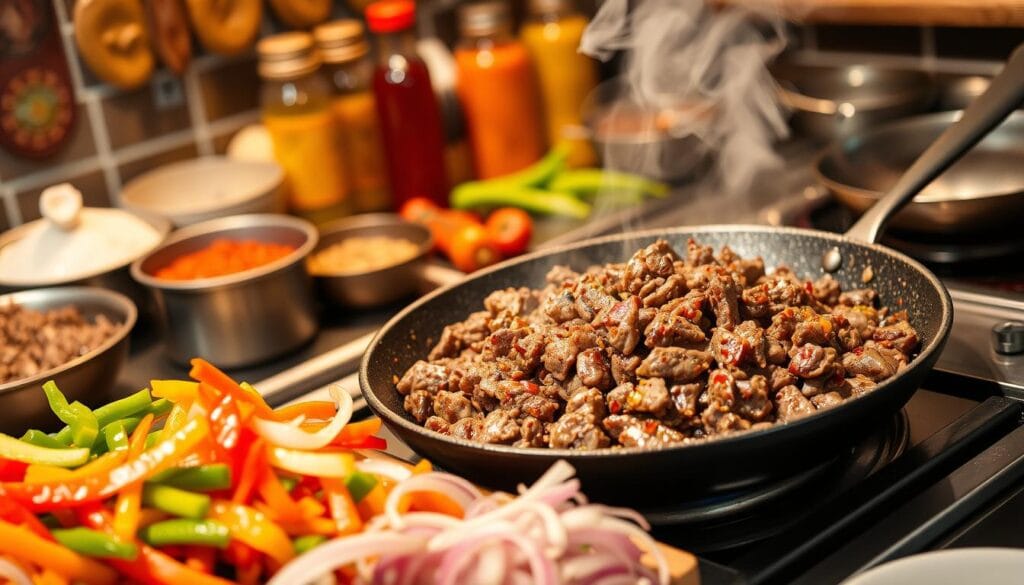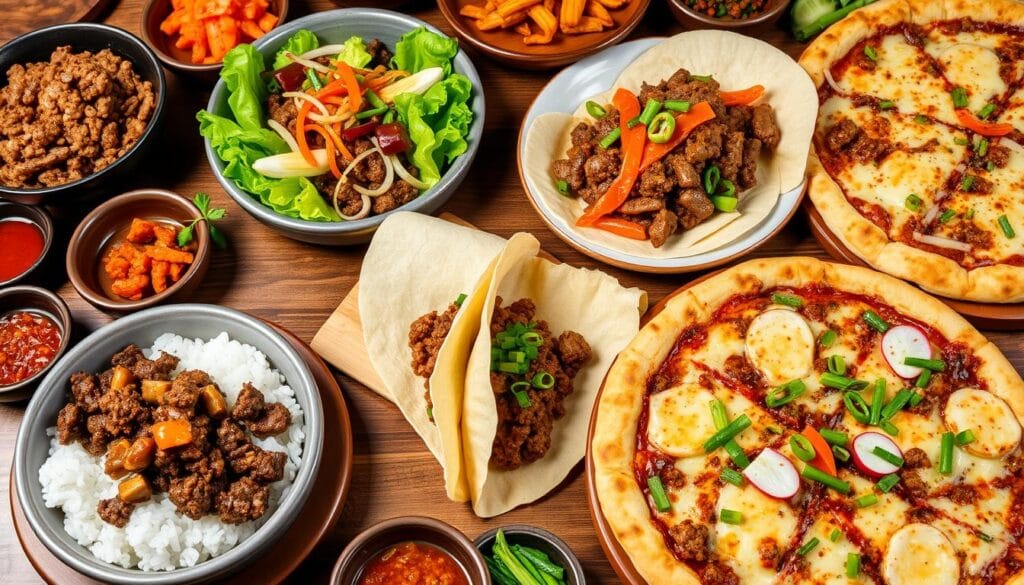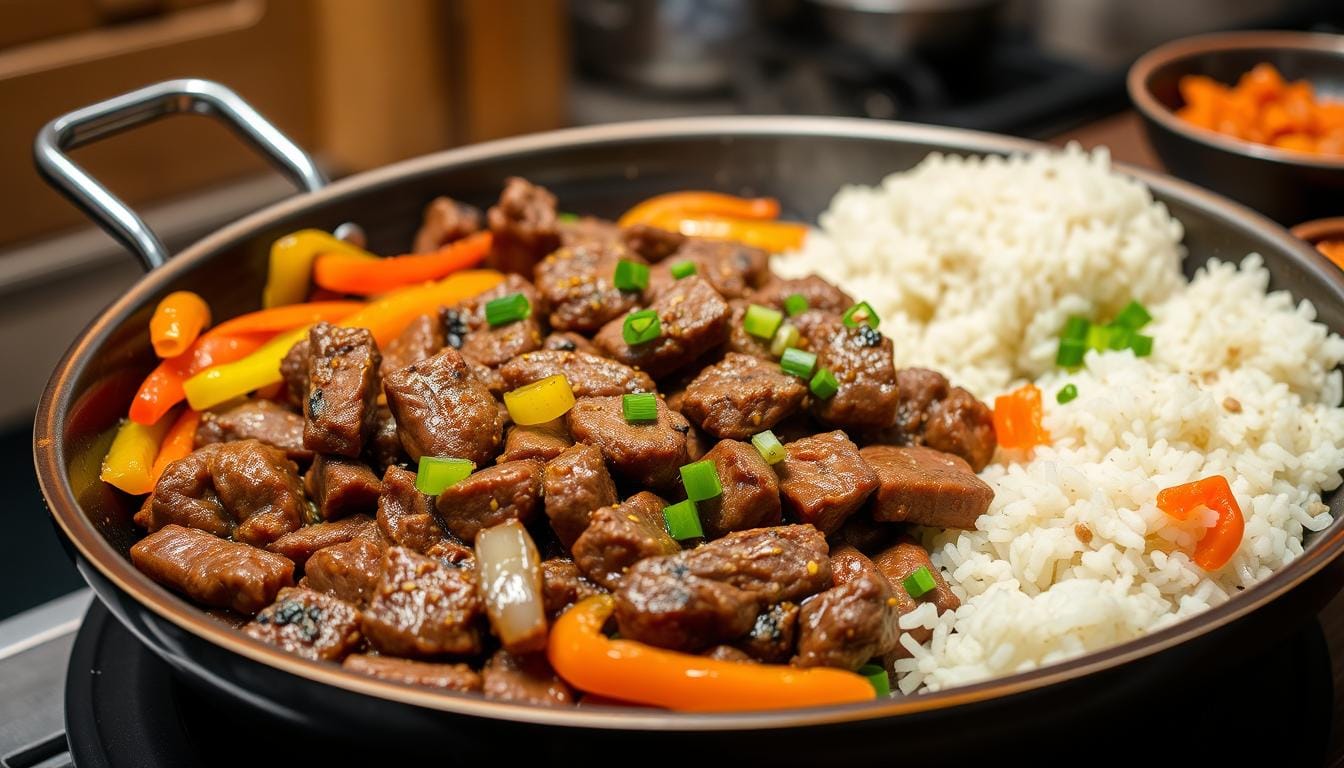Walking into the kitchen, the smell of sizzling meat and spices takes me back to family gatherings. Those were times when sharing a meal brought us all together. Today, I’m excited to share an easy bulgogi recipe that will delight your taste buds and take you on a flavorful journey.
Bulgogi is the heart of Korean BBQ, with tender meat and a mix of sweet, savory, and umami flavors. This recipe uses ground beef, making it quick and easy for a weeknight dinner. It’s ready in just 30 minutes to cook, perfect for busy evenings.
The marinade is the secret to this dish’s flavor. It’s a mix of soy sauce, brown sugar, mirin, sesame oil, and honey. This blend tenderizes the meat and adds a complex, irresistible taste. Whether you’re a Korean cuisine lover or new to bulgogi, this recipe will impress you with its bold flavor. Let’s explore how to make a quick and tasty Korean dish that everyone will love.
Table of Contents
What Is Bulgogi and Its Origins?
Bulgogi is a favorite in Korean cuisine. It’s marinated and grilled meat. The name “bulgogi” means “fire meat” in Korean, showing how it’s cooked over an open flame. Authentic bulgogi has a long history in Korea, highlighting the importance of beef in their food.
Understanding the Dish
Bulgogi is known for its mix of sweet, savory, and umami flavors. The marinade, with soy sauce, sugar, garlic, ginger, and sesame oil, tenderizes the meat. It also adds a complex taste.
A Look into Korean Cuisine
- In recent years, Bulgogi has become more popular worldwide. This is thanks to the growing interest in Korean culture, leading to Korean barbecue restaurants in big cities.
- Bulgogi has inspired new dishes like Bulgogi tacos and Bulgogi burgers. This shows how versatile and adaptable it is in different cuisines.
- Back in the Joseon Dynasty, Bulgogi was a favorite of Korean nobility. It was a sign of luxury and served at special events.
| Characteristic | Description |
|---|---|
| Marinade Composition | The marinade for Bulgogi includes soy sauce, sugar, garlic, ginger, and sesame oil. Sometimes, pear or apple is added for sweetness. This mix creates a delicious blend of flavors. |
| Cooking Method | Bulgogi is marinated in a flavorful sauce for hours or overnight. Then, it’s grilled over an open flame or on a stovetop griddle. This creates a caramelized crust and a smoky smell. |
| Serving Style | Traditionally, Bulgogi is served in “ssam” style. This means grilled meat is wrapped in lettuce or perilla leaves with condiments. It’s a fun and communal way to enjoy the dish, perfect for gatherings. |
Key Ingredients for Your Bulgogi
Making a great bulgogi starts with the right ingredients. The base is lean ground beef. But the marinade is where the magic happens, adding amazing flavors to the meat.
Ground Beef: The Right Choice
Choose lean ground beef for the best bulgogi. The meat should be tender and well-marbled. Sirloin or chuck are great options, offering flavor and juiciness.
Marinade Essentials
- Soy sauce: This liquid tenderizes the beef and adds a rich umami flavor.
- Brown sugar: It balances the soy sauce’s saltiness, creating a perfect taste.
- Sesame oil: A few tablespoons add a nutty aroma and richness.
- Garlic and ginger: These add depth and complexity to the marinade.
- Red pepper flakes: A small amount adds a mild kick (optional).
Optional Add-Ins for Flavor
You can also add extra ingredients to your bulgogi. Some popular choices include:
- Green onions: Finely chopped green onions add a fresh oniony flavor.
- Mushrooms: Sliced mushrooms, like button or shiitake, bring earthy and umami notes.
- Mild chili peppers: They add a touch of mild heat, enhancing the flavors.
The marinade is key to a great bulgogi. By mixing soy sauce, sweetness, and aromatic seasonings, you’ll get the true essence of this Korean dish.
Preparing the Marinade
To make a delicious bulgogi marinade, mix some important ingredients together. Start with soy sauce, brown sugar, mirin, and oyster sauce in a bowl. Add minced garlic, toasted sesame oil, and black pepper to balance the flavors.
This marinade gives the beef a tasty Korean bulgogi flavor and makes it tender. Asian pears in the marinade help tenderize the meat. Use thin beef slices for the best results.
Step-by-Step Marinade Instructions
- In a large bowl, combine 1/2 cup soy sauce, 1/4 cup brown sugar, 2 tablespoons mirin, and 2 tablespoons oyster sauce.
- Mince 3 cloves of garlic and add them to the marinade.
- Stir in 1 tablespoon toasted sesame oil and 1 teaspoon freshly ground black pepper.
- Add 1 pound of thinly sliced beef (such as sirloin or ribeye) and gently mix to ensure the meat is fully coated.
Best Practices for Marinade Timing
For tender and flavorful bulgogi, marinate the beef for 15 minutes to 24 hours. Thinner cuts might only need 10 minutes, while thicker cuts like Costco’s 3mm slices need 30 minutes.
Marinating overnight lets the flavors fully penetrate the meat. But, marinating for more than 24 hours can make the meat tough. So, watch the time carefully.
“The key to perfect bulgogi is in the marinade. Take the time to let the flavors meld and the meat tenderize for best results.”
Cooking Techniques for Bulgogi
There are two main ways to cook delicious Korean BBQ bulgogi at home. You can use the stovetop or grill it. Both methods make the dish taste amazing, with rich, caramelized flavors.
Stovetop Method
To cook bulgogi on the stovetop, heat a large wok or skillet over medium-high heat. Add oil to the pan and sauté the onions until they’re clear. Then, add the marinated stovetop bulgogi and cook for about 12 minutes.
This lets the meat get a nice caramelized crust. It also brings out the bold, savory flavors of the dish.
Grilling Bulgogi: Tips and Tricks
Grilling your Korean BBQ techniques bulgogi adds a smoky taste. Use a grill pan to keep the meat from falling through the grates. Cook the marinated beef over medium-high heat.
Seal the edges to get a crispy texture while keeping the inside juicy. The smoky flavor complements the dish’s other tastes.
Whether you choose stovetop or grilling, cook the cooking bulgogi until it’s seared and done, about 2 to 3 minutes per side. Don’t overcook it, as it can become tough. Serve it with traditional sides or modern pairings for a great experience.

Serving Suggestions
There are many ways to serve homemade bulgogi. Traditionally, it’s enjoyed with steamed short-grain rice and Korean side dishes called banchan. Common banchan include spicy kimchi, blanched veggies like broccoli, and toasted sesame seeds.
For a modern twist, try a bulgogi bowl. Use cauliflower rice or lettuce leaves as the base. Add the bulgogi and top with cucumber, bell peppers, and shredded carrots. This is a low-carb, tasty meal that highlights bulgogi’s versatility.
Traditional Accompaniments
- Steamed short-grain rice
- Spicy kimchi
- Blanched broccoli or other vegetables
- Toasted sesame seeds
Modern Pairings to Try
- Bulgogi bowl with cauliflower rice or lettuce leaves
- Bulgogi wrapped in fresh lettuce leaves for a lighter meal
- Bulgogi served over a bed of mixed greens or roasted vegetables
“The key to a delicious bulgogi experience is finding the right balance of flavors and textures. Experiment with different accompaniments to discover your perfect pairing.”
Storing Leftovers
Enjoying homemade bulgogi doesn’t have to end with one meal. You can enjoy it for days with the right storage and reheating. Let’s look at the best ways to keep and reheat your bulgogi.
Proper Refrigeration Techniques
Store leftover bulgogi in an airtight container in the fridge for 3-5 days. Make sure it cools down first to avoid moisture buildup. This helps prevent bacterial growth.
Keeping meat and veggies separate helps keep their texture and taste. This way, your bulgogi stays fresh and flavorful.
Reheating Tips for Best Taste
To enjoy your bulgogi again, follow a few easy steps. Reheat the meat in a skillet over medium heat. Add a bit of water or broth to keep it moist.
You can also microwave it for 1-2 minutes. Just add a splash of liquid to keep it moist. For the best taste, reheat meat and veggies together just before serving.
This method helps keep their textures and prevents veggies from getting soggy. With these tips, you can enjoy your bulgogi as part of a meal prep or as a tasty leftover.
| Refrigeration | Freezing |
|---|---|
| Bulgogi can be stored in an airtight container in the refrigerator for up to 3-5 days. | For longer storage, freeze portions of cooked bulgogi for up to 2-3 months. |
| Allow the meat to cool completely before refrigerating to prevent condensation. | Store the meat and vegetables separately to maintain their individual textures. |
| Store the meat and vegetables separately to maintain their individual textures. |
“The key to enjoying leftover bulgogi is proper storage and reheating. By following a few simple steps, you can savor the flavors long after your initial meal.”
Nutritional Benefits of Bulgogi
Bulgogi, a favorite Korean beef dish, is more than tasty. It’s also a healthy choice for a balanced diet. By knowing the health benefits of ground beef and adding veggies, you can enjoy healthy bulgogi. This dish offers great nutritional value and helps make a balanced Korean meal.
Health Aspects of Ground Beef
Ground beef, the main ingredient in bulgogi, is packed with protein. Each serving has about 31-55 grams of protein. This is key for building and keeping muscles strong. It also has iron and vitamin B12, important for health and well-being.
Incorporating Veggies into Your Meal
- To make your bulgogi even healthier, add a variety of vegetables to it.
- Vegetables increase fiber and add vitamins, minerals, and antioxidants.
- Adding sliced onions, carrots, and mushrooms can make your healthy bulgogi meal even better.
| Serving Size | Calories | Carbohydrates | Protein | Fat |
|---|---|---|---|---|
| 6 Servings | 738 | 68g | 55g | 25g |
| 7 Servings | 633 | 58g | 47g | 21g |
The balanced Korean meal of bulgogi is a tasty and nutritionally valuable option. It combines protein-rich ground beef with nutrient-dense veggies.
Variations of the Basic Recipe
The classic bulgogi with thinly sliced beef is loved by many. But, you can also try different versions to match your taste. Whether you want a vegetarian option or something spicier, there’s a lot to discover.
Vegetarian Bulgogi Options
For a meat-free version, use firm tofu, tempeh, or plant-based meat. Mushrooms, especially shiitake, can make it taste like meat. Just marinate your choice in soy sauce, sesame oil, garlic, and brown sugar for a tasty vegetarian dish.
Spicy Bulgogi Twist
Want it spicier? Add more red pepper flakes or gochujang to the marinade. You can also try ground chicken, turkey, or pork for a different taste.
Choosing a variation doesn’t change the marinade’s importance. The right mix of sweet, savory, and umami makes bulgogi special. So, get creative and enjoy the many ways to make bulgogi!

Tips for Perfectly Cooked Bulgogi
Getting the perfect texture and flavor in your homemade bulgogi (Korean BBQ beef) is all about mastering a few key techniques. Whether you’re a seasoned Korean BBQ enthusiast or a first-time cook, these bulgogi cooking tips will help you navigate the process and deliver a delectable dish every time.
Avoiding Common Mistakes
One of the most common mistakes when cooking bulgogi is overcooking the beef. To maintain a juicy and tender texture, be sure to cook the ground beef just until it’s no longer pink. Avoid letting it brown too much, as this can lead to a dry, tough final result.
Another crucial factor is ensuring your pan or grill is hot enough before adding the marinated beef. This helps create a nice sear and caramelization, which contributes to the authentic Korean BBQ flavor profile. Don’t overcrowd the pan, as this can cause the beef to steam rather than brown.
Achieving the Right Texture
For the best texture, it’s important to slice the beef against the grain, about 1/8-inch thick. This helps tenderize the meat and allows it to cook quickly. If you’re having trouble slicing, try chilling the beef in the freezer for 30 minutes before cutting – this will firm up the meat and make it easier to handle.
When it comes to the marinade, balance the sweet and savory elements to your taste. The right combination of soy sauce, brown sugar, garlic, and other seasonings will help the bulgogi achieve that perfect balance of flavors.
If you’re grilling your bulgogi, make sure to preheat the grill thoroughly to get those desirable charred edges that contribute to the authentic flavor. Adjust the heat as needed to prevent overcooking.
“The secret to delicious bulgogi is in the marinade and cooking technique. With a little attention to detail, you can achieve restaurant-quality Korean BBQ right at home.”
By following these tips and techniques, you’ll be well on your way to creating perfectly cooked bulgogi that will impress your family and friends. Experiment with different flavor profiles and cooking methods to find your personal twist on this beloved Korean classic.
Conclusion: Enjoy Your Homemade Bulgogi!
This easy bulgogi recipe with ground beef is a quick and tasty way to enjoy Korean flavors at home. You can make a delicious meal in under 30 minutes. Just remember to balance the marinade, cook the beef right, and add your favorite sides for a complete meal.
Recap of Key Points
This recipe shows you how to pick the right beef and make a great marinade. Marinating the meat for the right time and using techniques like partial freezing helps get the perfect texture and taste. Feel free to add your own touches and try different sides to make it special.
Encouragement to Experiment
Don’t be afraid to try new things and make this bulgogi recipe your own. You can add more spice or your favorite veggies to make it unique. With a little practice, you’ll be making amazing bulgogi at home that will impress everyone.

